Art Deco architecture originated in France before World War I. To me, the style epitomizes luxury, glamour, and exuberance. Unfortunately, the Hoosier State isn’t known as a hotbed for it unless you go out of your way to, say, the Fountain County Courthouse in Covington. Stumbling across an Art Deco building in a rural town is surprising!
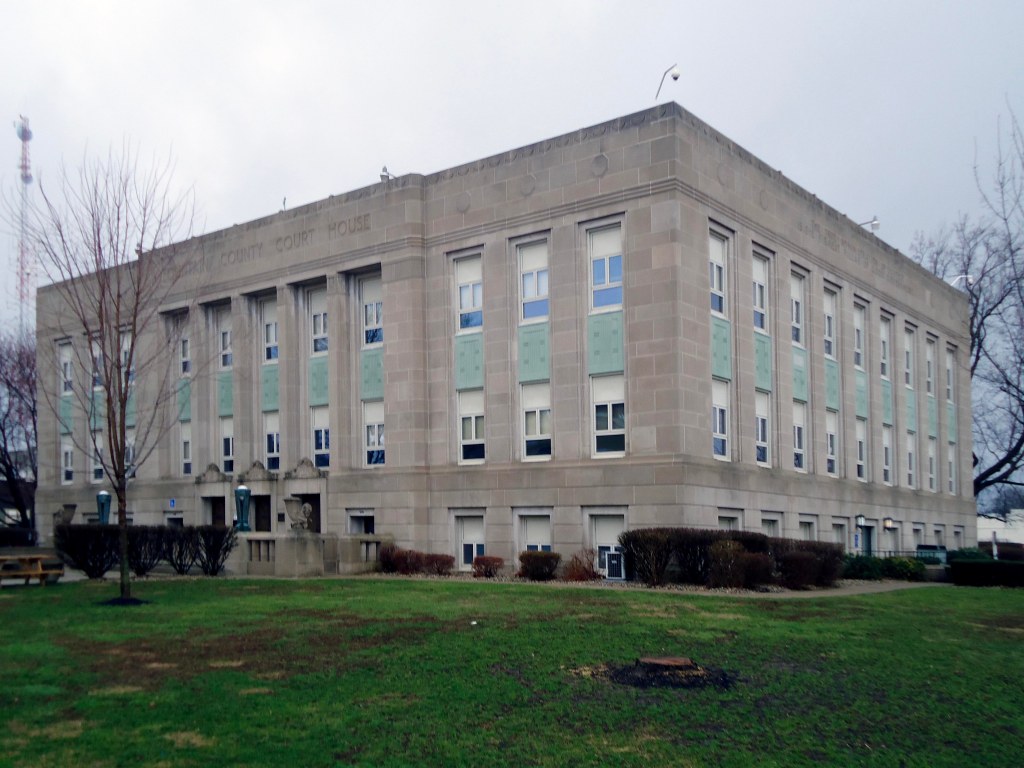
Here in Indiana, the Fountain County Courthouse is one of three that squeaked their way into existence thanks to Public Works Administration funds1. Fountain County’s third, it replaced a frame structure built in 1827 and a brick courthouse completed in 1833. The second was lost to fire before being rebuilt as a Gothic revival structure in 18612.
The third courthouse isn’t just markedly different from its successors: it also varies from most of Indiana’s courthouse portfolio and Art Deco buildings in general. In America, Art Deco buildings of the 1930s received designs heavily influenced by the Great Depression’s impact on the collective spirit of the nation3. In response, “stripped classic” or “classical moderne4” buildings like the one in Covington referenced neoclassical persuasions.
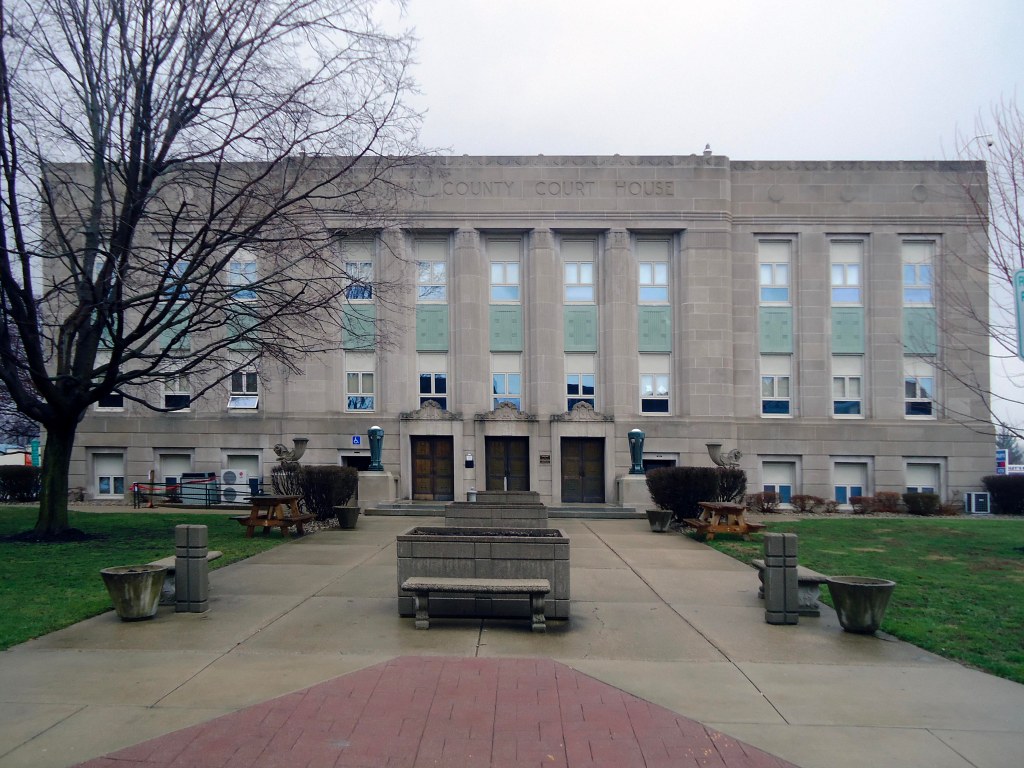
The exterior of the Fountain County Courthouse might have more in common with the classic revival courthouses in Delphi or Petersburg than with Art Deco gems like Fort Wayne’s Lincoln Tower or the Circle Tower in downtown Indy. Most of the resemblance is due to rectilinear lines and angles, but the Art Deco influence of the Fountain County Courthouse shines through in its details.
Geometric paneled window stacks, spandrels, and pilasters give the Fountain County Courthouse away as an Art Deco structure. So do plant forms carved into the columns of its main entryway, four-foot bronze lanterns, and weird sculptures. Those statues, featuring the head and legs of a ram and a torso that turns into an upwardly-curving vase, appear to have been the creation of a sculptor hired under the purview of the Federal Arts Project5.
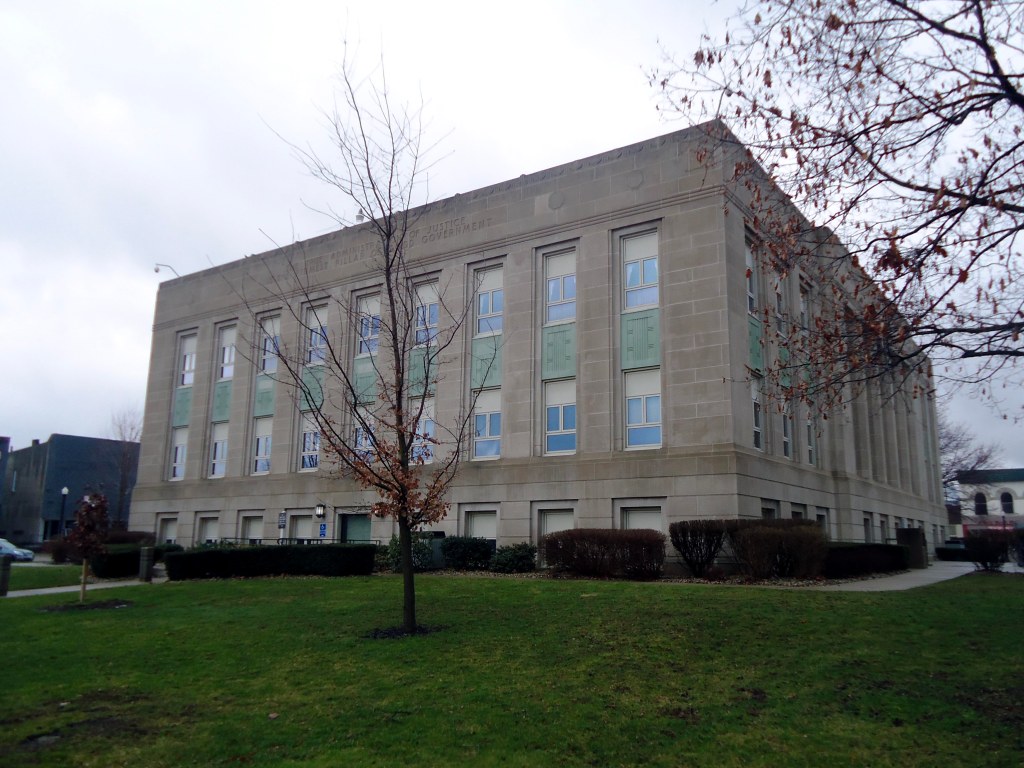
Those features are great, but my favorite is the building’s verdigris spandrels, those green blanks that separate its windows that are absent from the other Art Deco courthouses in Kokomo and Shelbyville. Architect Walter Scholer to thank for them. They’re made of Rostone, a material that originates from waste shale and limestone6.
Scholer was an Indiana architect responsible for transforming courthouses in Lawrence and Porter Counties. Always looking forward, he jumped at the chance to design a home with Rostone when he was commissioned to build a prototypical house for the 1933 Chicago World’s Fair! Although the material was billed as maintenance free, it began to fail on the house after twenty years7. Fortunately, the Rostone on the Fountain County Courthouse has survived much longer.
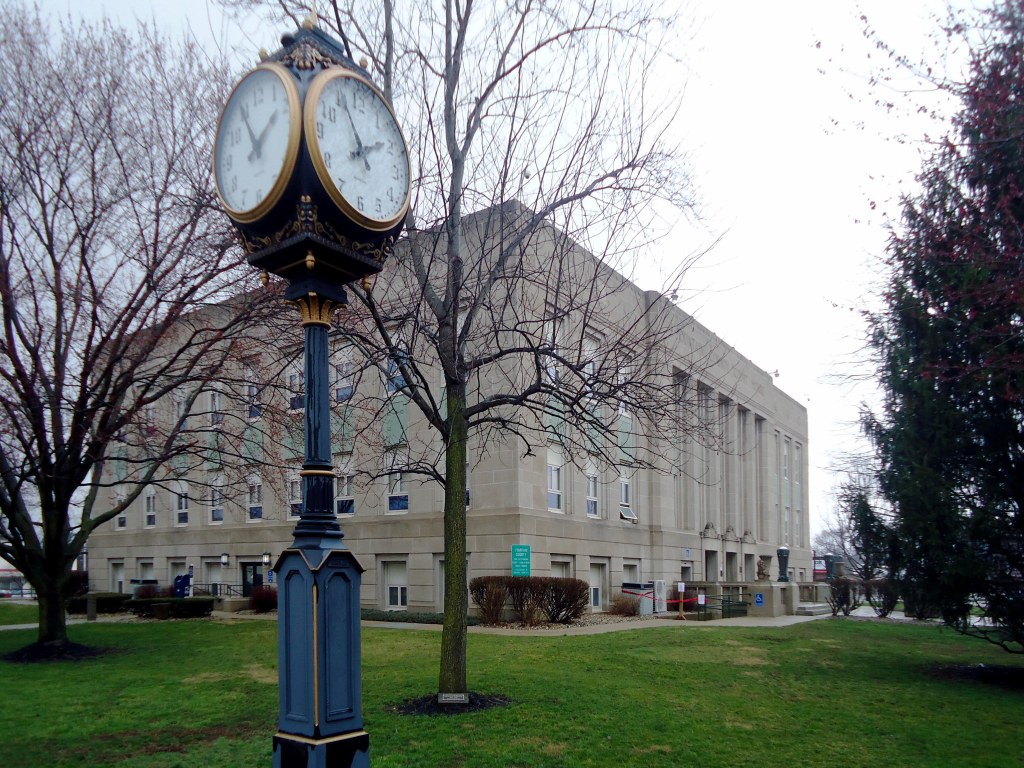
The limestone-and-Rostone exterior of the Fountain County Courthouse is unique, but its interior is something else. After entering through its northern entrance, visitors come to a vestibule with 10×15 foot murals painted by Covington-born artist Eugene Savage. The rotunda emerges from there and features a 32-square-foot wire-glass skylight.
Its skylight aside, the rotunda contains three jaw-dropping elements. An enormous split staircase, pink marble facings, and 2,500-square-foot mural make the interior truly majestic. In fact, the entire courthouse was designed around the artwork.
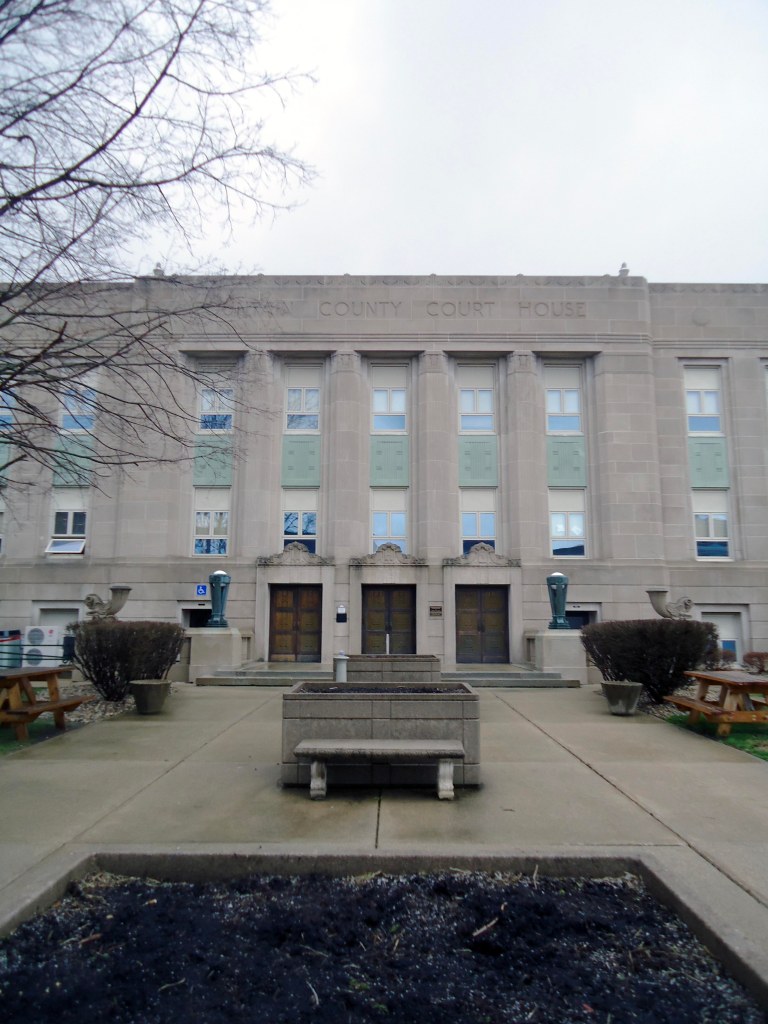
The building’s second-story courtroom still features original built-in oak furnishings, Art Deco light fixtures, and linoleum floors. Unfortunately, two of the courthouse’s notable spaces -it’s commissioners room and assembly hall- have been significantly altered over the past eighty-seven years. Most of the historic courthouse has been preserved, though, and it’s a big win for tiny Covington.
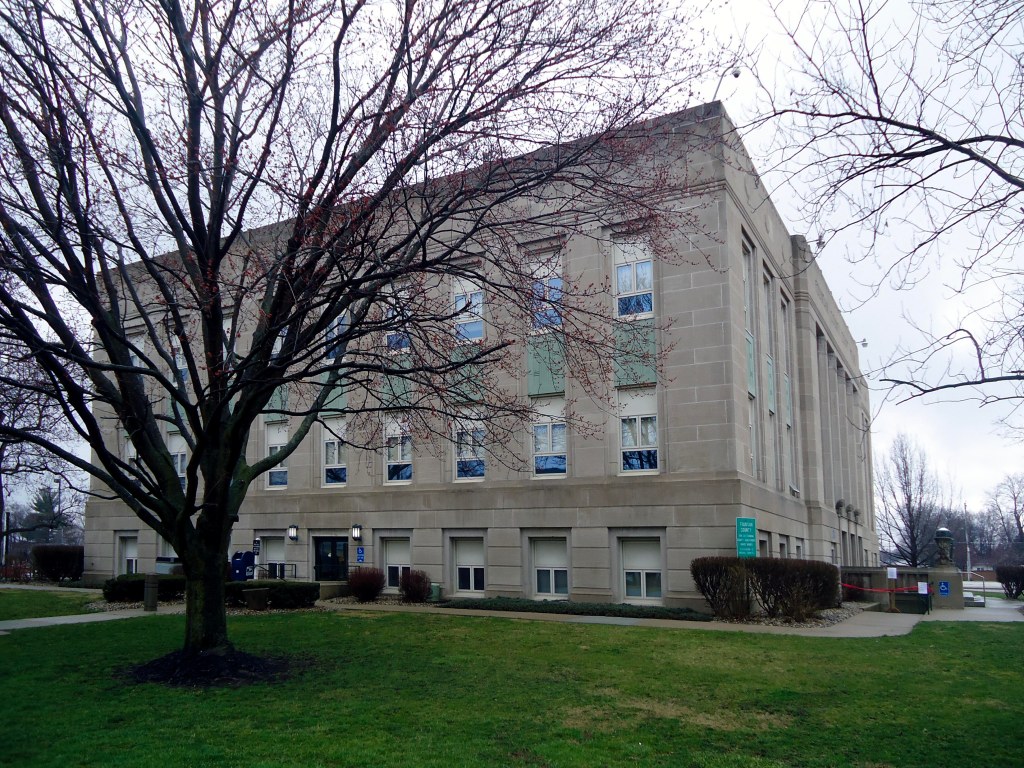
I only briefly stopped in Covington on a day when the weather wasn’t cooperating with my camera. Thankfully, stumbling across the Art Deco courthouse in Covington was a captivating experience. Who knew that such a stylish building defined such a little business district? Fountain County holds a rare piece of Indiana history in its Art Deco Courthouse, and its juxtaposition against Covington’s rural setting isn’t something I’ll soon forget.
TL;DR
Fountain County (pop. 16,880, 78/92)
Covington (pop. 2,607)
53/92 photographed
Built: 1937
Cost: $246,734 ($4.12 million in 2016)
Architect: Louis Johnson and Walter Scholer
Style: Art Deco
Courthouse Square: Shelbyville Square
Height: 3 stories
Current use: County offices and courts
Photographed: 3/13/16
Sources Cited
1 Enyart, David. “Howard County” Indiana County Courthouse Histories. ACPL Genealogy Center, 2010-2018. Web. Retrieved 5/9/20.
2 Courthouse History. Keith Vincent. Web. Retrieved 5/9/20.
3 National Register of Historic Places, Fountain County Courthouse, Covington, Fountain County, Indiana, National Register # 08000191.
4 Weber, E. “Art Deco in America”. Simon and Shuster, Exeter Books [New York]. 1985. Print.
5 Short, C.W., & Stanley- Brown, R. “Public Buildings: A Survey of Architecture” United States Government Printing Office ]Washington, D.C.]. 1939. Print.
6 Collins, J.E., Boquiren, J.A., & Culberson, L.J. “Wieboldt-Rostone House; HABS No. IN-240” Historic American Buildings Survey; National Park Service, Department of the Interior; Washington, DC; 1994.
7 McKee, A.M. “Stonewalling America: Simulated Stone Products”. CRM: Preserving the Recent Past.” Volume 18, Number 8. 1995. Print.

TIL the word “spandrel!”
LikeLiked by 1 person
Happy to be of service Sally. If you’re like me, you’ll now point them out everywhere you go. “Oh- there’s a spandrel. There’s a spandrel! look over there! That’s a spandrel, isn’t it?”
Unfortunately, I’ve learned that not everything is a spandrel.
LikeLike